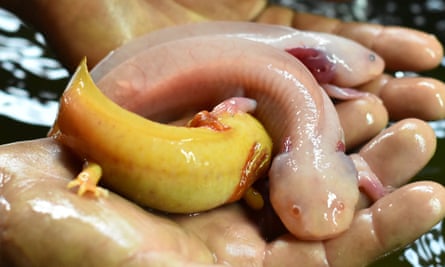On Friday, ecologists from Mexico’s National Autonomous University restarted a fundraising initiative to support the protection of axolotls, an endangered species of fish-like salamander native to the region.
The initiative, known as Adoptaxolotl, requests individuals to contribute a minimum of 600 pesos (equivalent to $35) to virtually adopt a miniature “water monster”. Virtual adoption includes receiving real-time updates on the axolotl’s well-being. For a lower amount, contributors can purchase a virtual meal for one of these creatures, which are quite trendy as pets in the United States.
Scientists leading the fundraiser have reported that the population of Mexican axolotls in their primary habitat has declined by 99.5% in less than twenty years.
The Adoptaxolotl campaign from last year generated over 450,000 pesos ($26,300) for a captive-breeding program and restoration of the Aztec canals in Xochimilco, a borough in southern Mexico City.
However, according to Alejandro Calzada, an ecologist conducting a survey on lesser-known species of axolotls for the government’s environment department, there is a lack of sufficient resources for comprehensive research.
“Our team of nine researchers is unable to adequately monitor all the streams in Mexico City, let alone the entire country,” stated Calzada. “The scope of our monitoring is insufficient for such a large area.”

Although the axolotl has gained popularity, nearly all 18 species in Mexico are at risk of extinction due to increasing water pollution, a lethal amphibian fungus, and the presence of non-native rainbow trout.
According to the most recent census from the National Autonomous University, there has been a significant decline in the population of axolotls in Mexico. While scientists used to find an average of 6,000 axolotls per square kilometer, there are now only 36. Furthermore, a global study revealed that there are less than 1,000 Mexican axolotls remaining in their natural habitat.
One of the scientists from the university, Luis Zambrano González, announced the fundraising effort and expressed his goal to initiate a new census in March, which would be the first one since 2014.
Zambrano stated that there is not enough time left to visit Xochimilco due to the overwhelming presence of pollution, such as soccer fields and floating dens. He expressed his sadness over this issue.
Without information on the quantity and spread of distinct axolotl species in Mexico, it is difficult to determine the remaining lifespan of these creatures and how to best allocate available resources.
Calzada stated that it is imperative for us to work quickly.
Ignore the advertisement for the newsletter.
after newsletter promotion
Axolotls, with their distinct, slippery appearance and remarkable capacity for limb regeneration, have become a renowned symbol in Mexico. Researchers in various laboratories believe that this regenerative ability may hold the key to tissue restoration and potentially even cancer treatment.
Previously, governmental initiatives for preserving wildlife have primarily prioritized the Mexican axolotl, which inhabits Xochimilco. However, various other species can be found throughout Mexico, ranging from small streams in the Valley of Mexico to the desert of Sonora in the north.
The rapid growth of Mexico City’s urban development has negatively impacted the water quality of its canals. Additionally, in the lakes surrounding the city, rainbow trout from fish farms can potentially harm the native axolotl population by competing for food and space.
According to Calzada, his team has been noticing a growing number of axolotls that are dying from chytrid fungus. This disease, which eats away at the skin, has resulted in widespread amphibian deaths throughout Europe and Australia.
Academics depend on donations, while Calzada’s group relies on a group of volunteers. However, the Mexican government has recently passed a decision to reduce funding for its environment department by 11%.
According to an analysis of Mexico’s 2024 budget, the current administration, led by President Andrés Manuel López Obrador, will have allocated 35% less funding to the country’s environment department compared to the previous administration during its six-year term.
Source: theguardian.com


